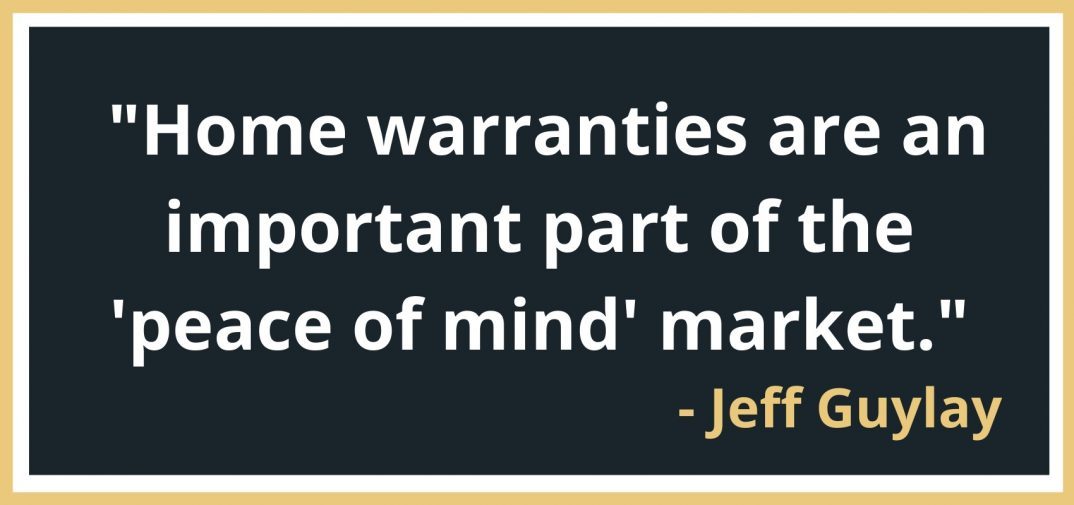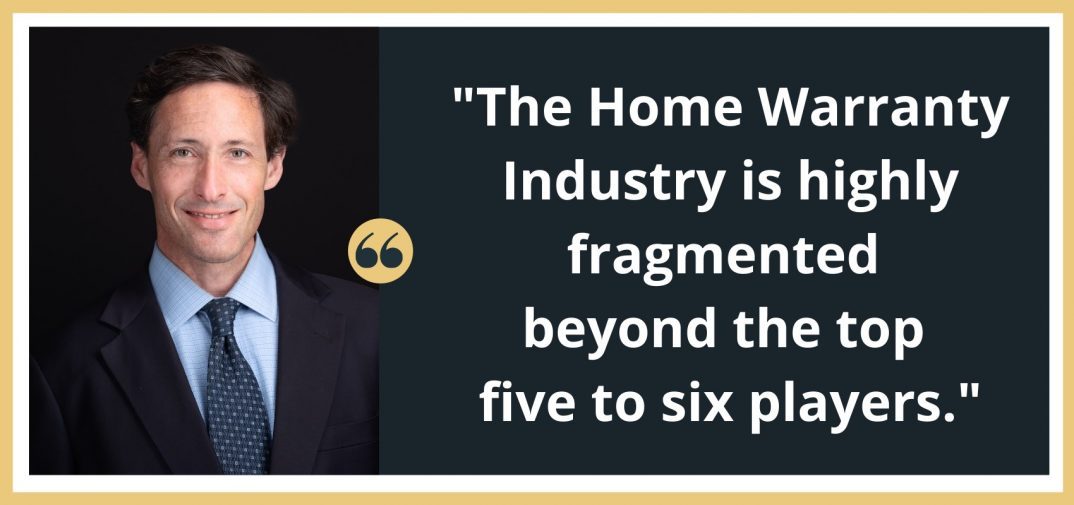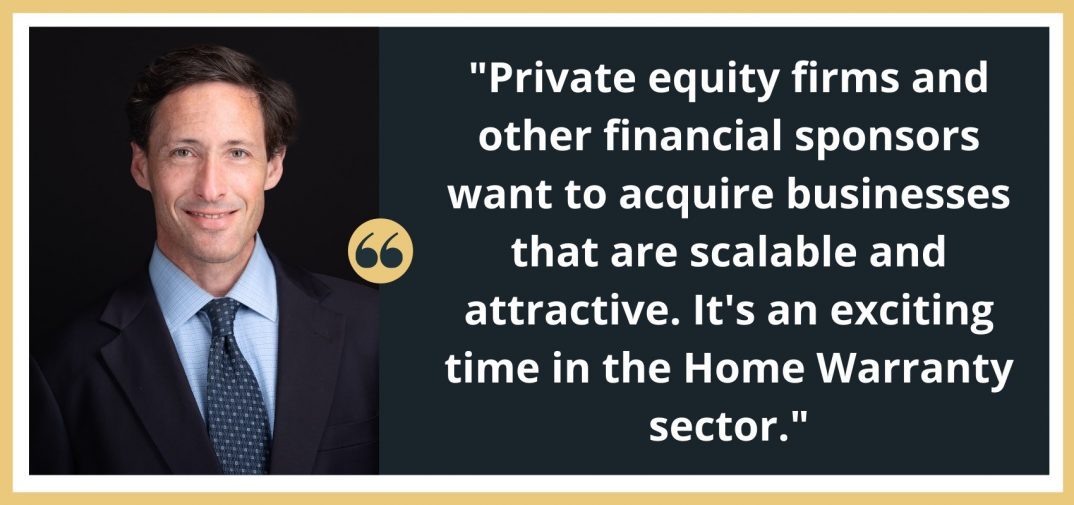This episode continues our series of “industry spotlights,” focusing on specific trends and opportunities in middle-market M&A transactions. Previous episodes include Insurance Premium Finance, Vehicle Service Contract Administrators, and Automotive Reconditioning.

The Home Warranty industry is a $2.6B+ high-growth industry that Colonnade believes will experience significant consolidation in the years to come. Colonnade’s industry focus allows us to deeply know the industry players and provide exceptional service to clients who hire us to assist them in a transaction.
In this episode, we answer the following questions:
- How does the Home Warranty industry fit into the service contract industry and what services does it offer?
- What players are involved in the Home Warranty industry?
- What do typical Home Warranty contracts look like?
- How big is the Home Warranty industry?
- Who are some of the industry players?
- What is driving high growth in this industry?
- What is driving M&A activity in the home warranty sector?
- What advice would you give to owners of Home Warranty companies to get them ready to go to market?
How does the Home Warranty industry fit into the service contract industry and what services does it offer? (1:45)
Jeff Guylay: The home warranty sector is part of the service contract industry, which includes the Vehicle Service Contract Industry (VSC). Instead of covering auto claims (like VSC) or structural issues with a home, home warranties cover items inside the home. Items covered by a home warranty may include heating and air conditioning systems, dishwashers, dryers, refrigerators, and any sort of major appliances.
Home warranties are an important part of the “peace of mind” products/services that allow buyers to know that future losses are covered for a period of time by the warranty.

Home warranties are a high-touch/high service product. When something breaks, the customer calls the warranty provider, and the administrator determines coverage. The administrator figures out who the right service provider is in the region and coordinates scheduling. The service provider shows up at the residence and fixes the issue. The interaction between the customer, administrator, and the network of service providers is key.
Presuming home warranty holders have a good experience, they choose to extend their warranty. Renewal rates for the industry (discussed further below) are high and are an essential part of the growth story of this industry. High renewals come from good service. Home Warranty providers have set up regional or national networks of reliable service providers who do good work and generally have pre-negotiated rates. It’s a better offering for everyone.
What players are involved in the Home Warranty industry? (3:20)
Jeff Guylay: There’s a seller, whether that’s a real estate broker facilitating a home sale or a direct-to-consumer (DTC) element. More often today, there are payment plan providers (discussed below). Administrators adjudicate claims and handle service. Of course, there’s a CLIP (Contractual Liability Insurance Policy) on the back end to guarantee claims.
What do typical Home Warranty contracts look like? (4:10)
Like auto warranties, home warranties generally come in different packages and have various levels of coverage. You might have different terms, products covered, exclusions, et cetera. A home warranty price ranges anywhere from a low end of ~$350 to several thousand dollars. They run in term from one year to three years, depending on how and when they’re sold.
How big is the Home Warranty industry? (4:50)
Jeff Guylay: We estimate that the total market for home warranties today is about $2.6 billion. Some estimates say this market is as large as $5 billion.
Who are some of the industry players? (6:00)
There are half a dozen or so giants in the sector. Frontdoor is the largest (previously part of Service Master/Terminix). Front Door has several brands in the market, including American Home Shield, Landmark, OneGuard, et cetera. They’ve amassed roughly 60% of the market.
Other companies include First American Home Warranty (part of First American Financial), Old Republic, Fidelity National (part of Fidelity National Financial), Cinch, and 2-10.
Those are the biggest players, and then there are about a hundred administrators and call centers focused on this segment. So it gets fragmented beyond the top five to six players.

What is driving high growth in this industry? (10:00)
Jeff Guylay: The home warranty industry is tied to the booming real estate industry, but the lion’s share of revenue comes from renewals, accounting for about 70% of revenue for the largest players. Point of sale in the home market is about 20%. The direct-to-consumer channel is about 12% of revenue. Significant opportunities for growth exist due to dynamics with the DTC channel, the innovation of payment plan providers, and opportunities to increase penetration rates. (Each discussed below).
Jeff Guylay: First, let’s discuss the DTC channel (12:00). These are call centers that are generating lists of existing homes and tapping into new home sales. These call centers are experienced with similar products (such as VSCs); they know the scripts, they understand how this business works, and they’re logically extending their presence into the home warranty market as another asset class.
Jeff Guylay: The involvement and innovation of payment plan providers also provide an opportunity for growth (13:00). In the last five to 10 years, the market has evolved to offer longer-term home warranties. These longer warranties are generally three years and more expensive but can be financed.
The payment plan provider is fronting the money to both the sellers and the administrators, holding back a reserve for cancellations, and injecting fuel into the system to help DTC marketers grow.
Jeff Guylay: Another trend is for payment plan providers to provide month-to-month financing and has sparked a lot of growth.
Gina Cocking (14:50). An interesting company is Everything Breaks. They offer a multi-year home warranty with a payment plan and month-to-month contracts. This innovation has been revolutionizing the industry.
Jeff Guylay (15:30): The potential for increased penetration rates holds promise for future growth in the industry. Industry averages estimate only about 5% penetration in homes across the US, which is remarkably low. We see penetration rates increasing due to good consumer experience, product awareness, and consumer adoption.
If the market is $2.6 billion, every percentage point of market penetration is another $500 or $600 million of market size. We could easily see the 5% go to 10%, so there’s a real growth opportunity in the market here.

What is driving M&A activity in the home warranty sector? (16:45)
Jeff Guylay: As we’ve reported in our recent Industry Report on the Home Warranty industry, there has been an uptick in M&A activity in the home warranty segment. We expect that to continue. We see the Home Warranty industry mimicking what we’ve seen in the VSC industry, with operators building up their DTC segment and call centers, shoring up administrators, and expanding their reach into a complementary asset class.
There are also positive industry fundamentals, including high growth, strong cash flows, recurring revenue, interested financial sponsors, and a deep exit market.
Jeff Guylay: Shore up your business. Look at your portfolio, loss curves, and cancellation rates.
A good acquisition target has a great management team, operations, systems, and compliance—the ability to scale. Also, something that’s unique or differentiating, whether it’s how you develop the call list, run the data analytics, attractively reach consumers, or cultivate relationships with real estate brokers or other sellers.
Understand that financial sponsors are looking for rollups. You may be a small regional company with a good presence in very few local markets. Those are good companies, but they’re probably not built to scale. Sponsors want to find a platform or a good add-on that brings distribution that you couldn’t get otherwise. Platform strategies work based on demographics, product offerings, or other strategic advantages. An advisor like Colonnade can help you see where your company fits in.
Private equity firms and other financial sponsors want to acquire businesses that are scalable and attractive. A number of players that succeeded in the VSC sector are going to transition into this market and are going to follow the same blueprint that they proved out successfully in the VSC segment. We expect to see an increase in M&A activity over the next couple of years. It’s an exciting time in this sector.

Colonnade has either been the sell-side or buy-side M&A advisor on many of the significant service contract transactions that have taken place over the last decade. These complex transactions require an investment banking team with deep industry knowledge. We have insider level mastery, evaluation, drivers of value, competitive positioning, business trends, and relevant metrics in these sectors. We talk to the right buyer universe every day, enabling us to provide superior deal execution to our clients. If you are a service contract or warranty company, or you are a potential buyer of one of these businesses, and you’re considering a transaction, please contact us, and we can help you think through your next steps.






